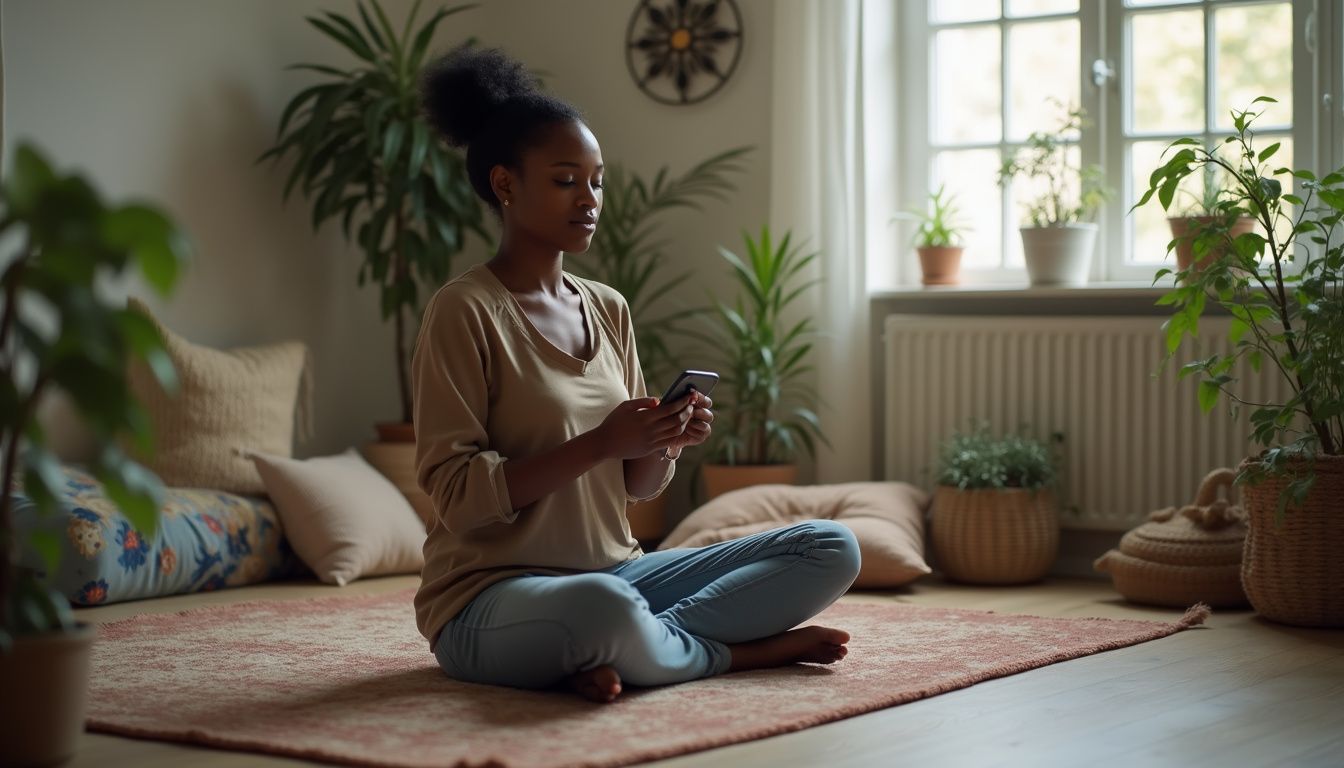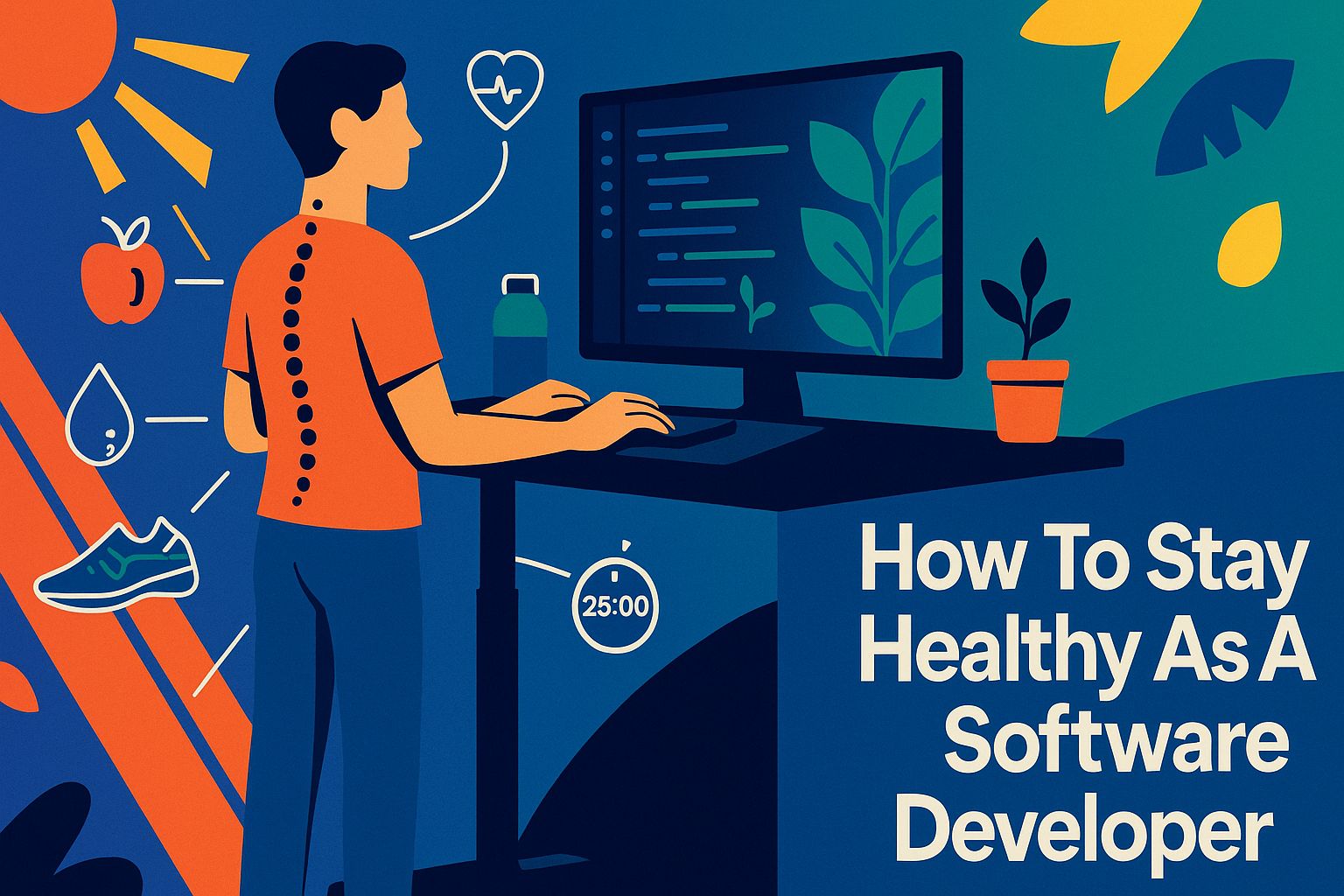Ever get so lost in your code that you look up and realize hours have vanished, but a nagging neck pain has mysteriously appeared?
If you’re a software engineer or programmer, you know exactly what I’m talking about. Your posture slowly morphs into a question mark, and the high from your third coffee gives way to a wired, exhausted feeling.
It turns out, we’re not alone in this. A 2022 survey from Haystack Analytics revealed that a staggering 81% of developers reported feeling burned out. It often stems from those late nights, grabbing whatever food is quickest, and letting exercise slide.
But here’s the good news, focusing on sleep, good nutrition, and regular physical activities can give you a major mood improvement and a real energy boost. This guide breaks down 13 proven tips on how to stay healthy as a software developer, all designed to fit into a real, chaotic life, not some perfect ideal.
I’m going to walk you through some simple ways to feel better, from desk stretches that actually work to snack ideas that won’t cause a sugar crash. Let’s get both your mind and body running as smoothly as your code.
Key Takeaways
To avoid burnout, try a structured break system like the Pomodoro technique (25 minutes of work, 3-5 minute break). Taking short, regular breaks for movement every hour boosts focus and reduces anxiety.
Staying hydrated is key. The Mayo Clinic suggests men aim for about 15.5 cups (124 ounces) and women 11.5 cups (92 ounces) of fluids daily. Using a smart water bottle like a HidrateSpark can help you track your intake automatically.
Reduce eye strain by using screen filters like f.lux or your operating system’s built-in night mode. Also, practice the 20/20/20 rule, look at something 20 feet away for 20 seconds every 20 minutes, using a tool like Eyeleo to remind you.
Choose healthy snacks like almonds, Greek yogurt, or dark chocolate (with at least 70% cocoa) to maintain stable energy. A 2023 study showed that flavonoids in dark chocolate can improve cognitive function, which is perfect for coding.
Combat imposter syndrome by tracking your wins in an app like Notion or Google Keep. Practice mindfulness techniques like SBNRR (“Stop, Breathe, Notice, Reflect, Respond”) to manage negative thoughts, a common struggle for programmers at all levels.
Table of Contents
Maintaining Physical Health

Your physical well-being is the hardware your brain runs on. Small tweaks to your routine can make a huge difference in how you feel day to day.
Some people explore supplements or meal shakes from brands like USANA Health Sciences to fill nutritional gaps. The goal isn’t to follow a rigid plan but to find what works for you and your body.
What is the best exercise routine for software developers?

The best exercise routine is the one you’ll actually stick with. Developer Leon Pahole found that he dreaded heavy weight-lifting and jogging but loved bodyweight training and biking. He wisely points out that you should ignore generic advice and pick something you genuinely enjoy.
That could be anything from martial arts to dancing. The key is consistent movement to combat a sedentary lifestyle.
Even a simple walk or bike ride offers huge benefits. A 2023 study from the University of Tsukuba found that just 10 minutes of moderate-intensity running improves both mood and executive function, a perfect reset after a long coding session.
Here are a few ideas to get you started:
- Embrace “Exercise Snacking”: This means doing short bursts of activity throughout the day. Think five minutes of push-ups or squats between meetings.
- Try At-Home Fitness: Follow along with channels like “Hybrid Calisthenics” on YouTube, which offers simple, gear-free workouts perfect for beginners.
- Gamify Your Cardio: Apps like Strava let you track your runs or bike rides and compete with friends, adding a fun, motivating layer to your workout.
- Make Your Commute Active: If possible, biking to work is a fantastic way to build fitness into your daily schedule.
You can find more workout ideas for developers online, but the main takeaway is to experiment and find what feels good to you.
Sustained routines only happen when people actually like the exercises.
Now that you’re moving more, let’s talk about undoing the damage of sitting all day with some simple stretches.
How can I incorporate stretching into my daily work routine?

Hours of coding can leave you feeling stiff and sore. A few minutes of stretching can do wonders for pain relief and your overall mental well-being.
The trick is making it a habit.
- Set a Reminder: Use a simple timer or an app like StretchClock to give you a nudge every hour. These small prompts help prevent fatigue and computer vision syndrome (cvs).
- Target Key Areas: Focus on your neck, shoulders, back, and wrists. A simple upper trapezius stretch, recommended by the American Chiropractic Association, can provide immediate relief for neck tension.
- Make It Enjoyable: Pahole mentioned his 10-minute daily stretch routine only became a habit once he paired it with his favorite music or a podcast.
- Use “Dead Time”: Sneak in quick five-minute stretches while waiting for code to compile or during a long conference call. No one on the video call needs to know you’re doing standing leg stretches.
- Try Desk Yoga: Simple moves like shoulder shrugs and wrist circles can be done right at your desk while you’re debugging.
- Find a Virtual Stretch Buddy: Team up with a coworker to send reminder texts. A little accountability goes a long way.
- Keep a Tool Handy: A resistance band is a cheap and effective tool to keep at your desk for deeper stretches that can help improve posture.
What are effective ways to improve posture while working?

Good posture is your best defense against back and neck pain. I used to be a chronic sloucher until I realized a few ergonomic tweaks could make a world of difference.
Your setup is everything.
- Get an Ergonomic Chair: This is a worthy investment. A quality chair like the Herman Miller Aeron or the Steelcase Gesture provides lumbar support to maintain your spine’s natural curve. Look for chairs that meet BIFMA standards for durability and safety.
- Raise Your Screen: Use a laptop stand or monitor arm to position the top of your screen at or just below eye level. This prevents you from hunching forward.
- Use an External Keyboard and Mouse: An external keyboard, like the Kinesis Freestyle Edge, allows you to position your hands and wrists naturally, with your elbows at a 90-degree angle.
- Consider a Standing Desk: Alternating between sitting and standing is ideal. A height-adjustable table, now common in offices at companies like Google, can reduce sedentary time.
- Try a Posture Reminder App: A wearable device like the Upright Go 2 provides a gentle vibration when you start to slouch, helping you build muscle memory.
- Keep Your Feet Flat: Adjust your chair height so your feet rest comfortably on the floor. This helps distribute your weight evenly.
Correcting your posture is a marathon, not a sprint. Be patient and consistent, and your back will thank you.
How often should I take breaks from my desk?

Taking regular breaks is one of the most effective ways to maintain focus and prevent burnout. Your brain isn’t designed for hours of uninterrupted, deep concentration.
Many developers swear by the Pomodoro technique. You work in a focused 25-minute sprint, then take a short 3-5 minute break. After four cycles, you take a longer break of 15-30 minutes.
However, that’s not the only method. A study by the Draugiem Group found that the most productive employees worked for an average of 52 minutes followed by a 17-minute break. The key is finding a rhythm that works for you.
Research from the University of Illinois shows that brief diversions from a task can dramatically improve one’s ability to focus on that task for prolonged periods.
Use an app like TimeOut for Mac or Stretchly for Windows to enforce these breaks. During your time off, step away from the screen. Walk around, do some stretches, or grab a glass of water. This simple act can boost focus, reduce anxiety, and keep your creativity flowing.
Staying Mentally Healthy

Your mind is your most valuable tool, and it needs maintenance just like any complex system. Burnout and imposter syndrome are incredibly common in our field, but they don’t have to be your reality.
Tools like meditation apps Headspace or Calm can be a great starting point. Let’s explore how to keep your mental health in top shape.
How can I manage imposter syndrome as a developer?

That nagging feeling that you’re a fraud and will be “found out” at any moment? That’s imposter syndrome, and it’s practically an epidemic in tech. A 2020 study by Blind, an anonymous professional network, found that 58% of tech employees experience it.
Here are some practical ways to fight back:
- Keep a “Brag Document”: Take five minutes each week to write down your accomplishments in a tool like Notion or Google Keep. Did you solve a tricky bug? Help a junior dev? Write it down. Reviewing this list provides concrete evidence against that negative inner voice.
- Practice SBNRR: When you feel a negative thought spiral starting, use this mindfulness technique, Stop, Breathe, Notice, Reflect, and Respond. It helps you interrupt the pattern instead of getting swept away by it.
- Talk About It: You’ll be surprised how many of your teammates, even senior engineers, feel the same way. Sharing your feelings on communities like the r/cscareerquestions subreddit can show you that you aren’t alone.
- Focus on Effort, Not Perfection: Reward yourself for making progress and learning, not for shipping flawless code on the first try. The goal is growth, not genius.
“Confidence is what happens when you’ve survived enough mistakes that failing stops scaring you.” – A senior engineer once told me this while sipping his third cup of decaf.
Remember that the feeling is just that, a feeling, not a reflection of reality. Next, let’s look at how mindfulness can quiet that inner critic.
What are some simple mindfulness or meditation practices?

You don’t need to join a monastery to get the benefits of mindfulness. It’s really about paying attention to the present moment without judgment. For us geeks, it’s a way to debug our own mental processes.
A study published by the National Center for Complementary and Integrative Health (NCCIH) confirms that meditation can reduce stress, anxiety, and pain.
Here are some easy ways to start:
- Use an App: Guided meditation apps are perfect for beginners. Headspace is great for foundational skills, while an app like Waking Up, created by neuroscientist Sam Harris, appeals to a more logical, analytical mind.
- Practice Box Breathing: This is a simple and powerful technique. Inhale for four seconds, hold your breath for four seconds, exhale for four seconds, and hold again for four. Repeat this a few times to quickly calm your nervous system.
- Do a Body Scan: During a break, close your eyes and mentally scan your body from your toes to your head. Just notice any sensations without trying to change them. This helps ground you in the present.
- Focus on a Single Task: Instead of juggling multiple things, try giving your full attention to one thing, whether it’s writing a function or drinking your coffee. This is mindfulness in action.
- Take Mindful Pauses: Set a timer for once an hour to just stop what you’re doing. Take three deep breaths and check in with yourself. How are you feeling physically and mentally?
Why should I develop hobbies outside of work?

Having a life outside of code is not a luxury, it’s a necessity for long-term health and creativity. Hobbies give your logical brain a much-needed break and can prevent your work from consuming your identity.
Research from San Francisco State University found that employees who engaged in creative hobbies outside of work were more creative and resourceful in their jobs.
Hobbies offer several key benefits:
- Stress Reduction: Activities like playing guitar, painting, or joining a board game group can significantly lower stress levels and help keep anxiety and depression at bay.
- New Challenges: Learning something new, whether it’s 3D printing or building mechanical keyboards, engages different parts of your brain and fosters personal growth.
- Social Connection: Joining a sports team or a book club helps you build relationships with people who don’t necessarily speak in code. These social bonds are crucial for fighting loneliness.
Many tech companies are now actively encouraging employees to pursue hobbies, recognizing that well-rounded, happier people make better, more resilient teams.
How can I effectively reflect on my progress regularly?

While hobbies give your brain a rest, regular reflection helps you stay aligned with your goals. It’s easy to get lost in the day-to-day grind and lose sight of the bigger picture.
Grab a notebook or use a tool like Todoist, as Pahole did, to jot down your thoughts. A simple weekly check-in can make a huge difference.
Ask yourself a few questions:
- What went well this week?
- What was challenging?
- Did I spend my time on things that matter to me?
- What is one thing I can do differently next week?
This practice helps you spot patterns early. You might notice that too many late-night debugging sessions directly lead to a bad mood or that you feel much better when you make time for a workout. This kind of self-awareness is key to preventing burnout.
“Tracking progress makes invisible victories visible, and that builds momentum.”
Healthy Eating Habits

What you eat directly impacts your focus, energy, and mood. A homemade meal will almost always beat fast food when it comes to sustained performance. And swapping that third soda for water can keep your mind sharp for hours.
How can I reduce or eliminate sugar from my diet?

Cutting down on sugar can feel like a huge challenge, especially when you’re tired and craving a quick energy hit. The key is to make small, sustainable changes.
Start by swapping sugar-loaded drinks for water. The American Heart Association recommends that men consume no more than 36 grams of added sugar per day and women no more than 25 grams. A single can of soda can contain more than that.
Get in the habit of reading the Nutrition Facts labels on packaged foods. You’ll be shocked at how much sugar is hiding in sauces, bread, and seemingly healthy snacks. Using an app like MyFitnessPal can help you track your intake and identify these hidden sources.
Instead of reaching for sugar, add flavor with spices like cinnamon, vanilla, or nutmeg. And when you need something sweet, opt for whole fruits, which provide fiber and nutrients along with natural sweetness.
What are healthy snack options for busy developers?

Having healthy snacks on hand is your best defense against the vending machine. The goal is to choose snacks that provide a mix of protein, healthy fats, and complex carbs to keep your energy stable.
Here are some great options to keep at your desk:
- Almonds and Walnuts: A handful of nuts provides protein and healthy fats. Walnuts are especially good as they are rich in omega-3 fatty acids, which support cognitive function.
- Greek Yogurt: It’s packed with protein and probiotics, making it a great choice for gut health and sustained energy.
- Berries: Blueberries and strawberries are full of fiber and antioxidants that support brain health.
- Dark Chocolate: A small piece of dark chocolate (70% cocoa or higher) can satisfy a sweet craving and provides a brain boost from antioxidants.
- Vegetables and Hummus: Carrot sticks, celery, or bell pepper strips with hummus offer fiber, plant-based protein, and a satisfying crunch.
- Healthy Bars: Look for bars with simple ingredients and low added sugar, like RXBARs or certain types of KIND bars.
Keeping these options within reach makes it easier to make a good choice when you’re in the middle of a marathon coding session.
How much water should I drink to stay hydrated?

Staying hydrated is one of the simplest yet most overlooked aspects of health. Even mild dehydration can cause brain fog, fatigue, and headaches.
The Mayo Clinic suggests a general guideline of 15.5 cups (124 ounces) of fluids a day for men and 11.5 cups (92 ounces) for women. About 20% of your daily fluid intake typically comes from food, but the rest needs to come from drinks.
A study in the *Journal of Nutrition* found that even a 1-2% level of dehydration can impair cognitive performance, which is a big deal when you’re trying to solve complex problems.
To make it easier, keep a large water bottle at your desk at all times. If you struggle to remember, consider a smart water bottle like a HidrateSpark that glows to remind you to drink. Set alarms on your phone or use a reminder app. Your brain, and your code, will benefit from it.
Managing Screen Time

Staring at a screen all day is just part of the job, but it doesn’t have to wreck your eyes or your sleep. Using tools like f.lux or your OS’s built-in night light can make a big difference. Keep reading for more ways to manage your screen time effectively.
How do I reduce blue light exposure when working?

Excessive blue light, especially at night, can interfere with your body’s production of melatonin, the hormone that helps you sleep. Luckily, there are several easy ways to reduce your exposure.
- Use Software Filters: Free software like f.lux automatically adjusts your screen’s color temperature based on the time of day, making it warmer and less blue in the evening. Most modern operating systems also have this built-in, like Night Shift on macOS and Night Light on Windows.
- Wear Blue Light-Blocking Glasses: A pair of glasses from a brand like Gunnar or Felix Gray can filter out blue light, reducing eye strain and helping to protect your sleep cycle, especially if you work late.
- Adjust Your Monitor Settings: Match your screen’s brightness to the ambient light in your room. Your screen shouldn’t look like a light source in a dark room.
- Keep Screens at a Distance: Position your monitor about 20 to 40 inches away from your eyes to reduce strain.
- Create a Device-Free Zone: Try to avoid using screens for at least an hour before bed. This gives your brain a chance to wind down and prepare for sleep.
What is the 20/20/20 rule and how does it help eye health?

The 20/20/20 rule is a simple but brilliant hack for preventing digital eye strain. It was developed by optometrist Dr. Jeffrey Anshel to help people who spend long hours in front of screens.
The rule is easy to remember, every 20 minutes, take a 20-second break and look at something 20 feet away.
This simple action relaxes the focusing muscles inside your eyes, which can help reduce issues like blurry vision and dry eyes. The American Optometric Association notes that a majority of people who work on computers experience symptoms of Computer Vision Syndrome, and this rule is a primary recommendation for relief.
To make it a habit, use a browser extension or app like Eyeleo or Stretchly to pop up a reminder. It’s a tiny interruption that can have a big impact on your comfort and focus throughout the day.
How Will Software Developers’ Health and Wellness Evolve in 2025?

The old “hustle culture” of caffeine-fueled all-nighters is slowly being replaced by a smarter, more sustainable approach to work.
Companies like Turing, which works with developers in over 150 countries, are increasingly offering work-life balance programs to prevent burnout. This is becoming the expectation, not the exception.
We’ll see more health and wellness tools integrated directly into our workflows. Think IDE plugins that enforce the 20/20/20 rule or team communication platforms that encourage taking mental health days.
With the demand for skilled programmers continuing to rise, companies recognize that the well-being of their developers is a critical asset. Prioritizing physical and mental health isn’t just a trend, it’s the new standard for a long and successful career in tech.
People Also Ask
What are some simple ways for software developers to stay healthy at work?
Use the Pomodoro Technique to schedule 5-minute walks, swap sugary snacks for almonds to aid brain function, and ensure your chair has proper lumbar support to maintain good posture.
How can I avoid eye strain while coding all day?
Follow the 20-20-20 rule recommended by ophthalmologists: every 20 minutes, look at something 20 feet away for 20 seconds, and use an app like f.lux to automatically reduce blue light in the evening.
Why is sleep important for programmers who want to stay sharp?
Getting 7-9 hours of sleep is crucial because your brain consolidates memory and clears out toxins, directly impacting your problem-solving abilities and cognitive performance the next day.
Can stress from tight deadlines hurt my health as a developer?
Yes, a 2023 JetBrains report showed that 73% of developers experience burnout, so taking short breaks for a 5-minute meditation with an app like Calm can help manage stress before it becomes overwhelming.
References
https://www.leonpahole.com/blog/post/stay-healthy-software-engineer-tips/
https://reviewnprep.com/blog/software-engineers-guide-to-physical-and-mental-health-plus-5-minutes-exercises/ (2023-03-13)
https://www.mitrais.com/news-updates/maintaining-good-posture-as-a-programmer/ (2022-10-20)
https://www.qodo.ai/blog/understanding-and-overcoming-programmer-imposter-syndrome-in-software-developers/ (2023-08-20)
https://generalassemb.ly/blog/mindfulness-for-web-developers/
https://newsinhealth.nih.gov/2021/06/mindfulness-your-health
https://www.tandfonline.com/doi/full/10.1080/01612840.2025.2512006
https://www.turing.com/blog/ways-to-maintain-good-mental-health-as-a-software-engineer (2025-02-21)
https://www.heart.org/en/healthy-living/healthy-eating/eat-smart/sugar/tips-for-cutting-down-on-sugar (2024-07-31)
https://www.developernation.net/blog/boosting-developer-productivity-with-healthy-snacking/ (2024-05-10)
https://www.linkedin.com/pulse/healthy-snacking-busy-software-engineers-easy-tasty-arav-hoijf
https://www.mayoclinichealthsystem.org/hometown-health/speaking-of-health/tips-for-drinking-more-water (2023-08-16)
https://www.facebook.com/groups/abletonliveusers/posts/3339096296200644/
https://www.nvisioncenters.com/education/20-20-20-rule/
https://www.healthline.com/health/eye-health/20-20-20-rule
https://dev.to/envitab/10-tips-for-being-a-healthy-tech-professional-842 (2024-04-12)
https://simpleprogrammer.com/developers-mental-physical-health/
